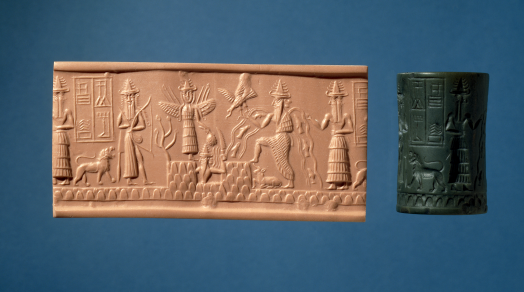
Cylinder seals were invented around 3500 BC in southern Mesopotamia – in what is now Iraq. They were generally made of stone and pierced through from end to end so that they could be worn on a string or pin. The surface of the cylinder was carved with a detailed design, so that when rolled on clay it would leave a continuous impression of the design. The writing that appears on the left of the impression identifies the owner as Adda, who is described as a scribe. We have to imagine Adda finishing writing a document in cuneiform script on a clay tablet and then rolling this seal across the soft clay to sign it.
Gods of Mesopotamia
The surface of the cylinder has been carved with a scene showing some Mesopotamian gods. The figure with streams of water and fish flowing from his shoulders is Ea, god of subterranean waters and of wisdom, who was one of the most powerful gods in Mesopotamia. Ea stretches out his right hand towards an eagle. Behind Ea stands the two-faced Usmu, Ea’s official. At the centre is Shamash, god of the sun, truth and justice, with sunrays rising from his shoulders. He is depicted cutting his way through the mountains in order to rise at dawn. Next on the left, perched on top of the mountain, is Ishtar, the winged goddess of love and war. The weapons rising from her shoulders symbolise her warlike characteristics; she also holds a cluster of dates. The god on the left of Ishtar, armed with a bow and quiver, has not been identified with certainty, but may represent a hunting god like Nusku who would have been called upon as a protective guardian, protecting sleeping people, bringing good dreams and preventing nightmares. The figures can be recognised as divine by their pointed hats with multiple horns.
Worshipping many gods
The Mesopotamians had hundreds of gods of varying importance and with different responsibilities. Some deities were connected with aspects of nature such as water and the sun; others were associated with geographical features such as rivers and mountains; still others had to do with aspects of human life including childbirth and making bread. The main occasions for public worship of the gods were festivals. These were held to ensure the continuing goodwill of the gods of a particular place or at important moments in the agricultural calendar such as harvest times. Each city had its own patron god or goddess, who would be housed in his or her own temple. There were also smaller temples throughout the city where ordinary people could make offerings. Many of the stories known to us from the Old Testament of the Bible are rooted in older Mesopotamian myths. The most famous example is the flood story in which Ea warns Atra-hasis and instructs him to build a boat to survive a great flood.
More information
Scene description
A more detailed description of the scene on the seal.
https://www.britishmuseum.org/research/collection_online/collection_object_details.aspx?objectId=368706&partId=1&searchText=Greenstone%20seal%20of%20Adda
Ten more seals
Ten cylinder seals to click through and explore.
https://www.britishmuseum.org/explore/highlights/articles/m/mesopotamian_cylinder_seals.aspx
Teacher's notes
These teacher notes for the British Museum’s Ancient Mesopotamia website useful information about different aspects of religion and examples of some Mesopotamian myths as well as ideas for class discussion.
http://www.mesopotamia.co.uk/staff/gods/resources.html
Gods and Goddesses
The website of the Ancient Mesopotamian Gods and Goddesses Project has detailed information on the gods. Some of the names are spelled or listed differently, for example, Ea is listed as Enki.
http://oracc.museum.upenn.edu/amgg/
More information
-
Scene description
A more detailed description of the scene on the seal.
Source: britishmuseum.org
-
Ten more seals
Ten cylinder seals to click through and explore.
Source: britishmuseum.org
-
Teacher's notes
These teacher notes for the British Museum’s Ancient Mesopotamia website useful information about different aspects of religion and examples of some Mesopotamian myths as well as ideas for class discussion.
Source: mesopotamia.co.uk
-
Gods and Goddesses
The website of the Ancient Mesopotamian Gods and Goddesses Project has detailed information on the gods. Some of the names are spelled or listed differently, for example, Ea is listed as Enki.
Source: upenn.edu


